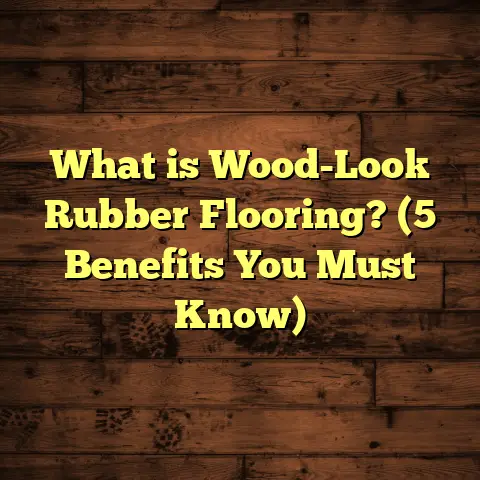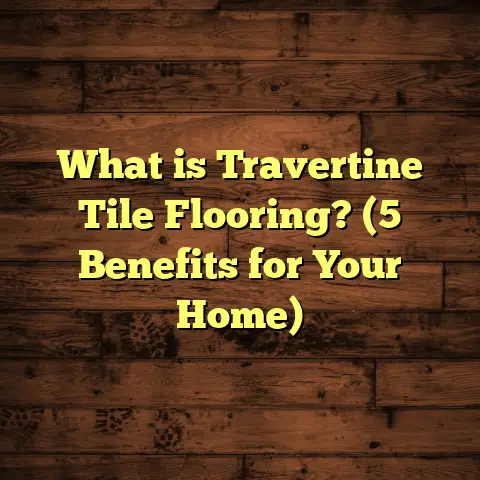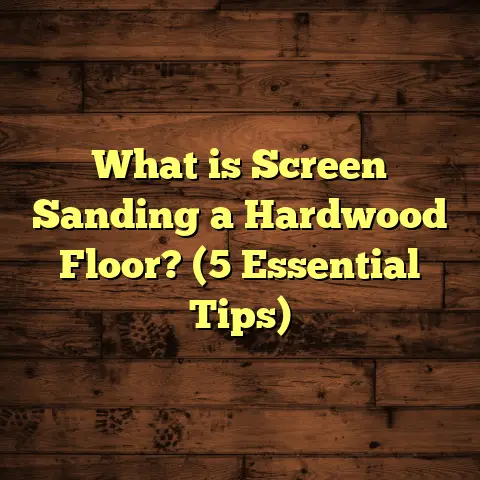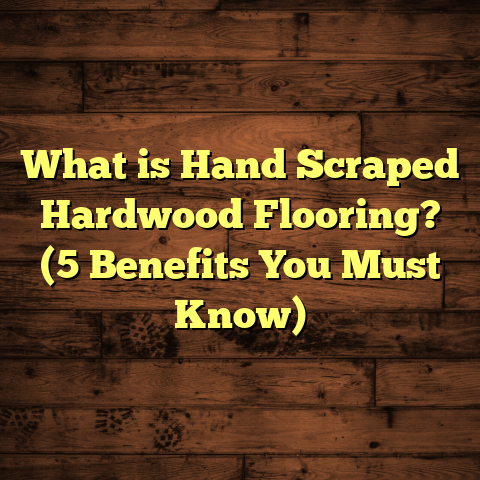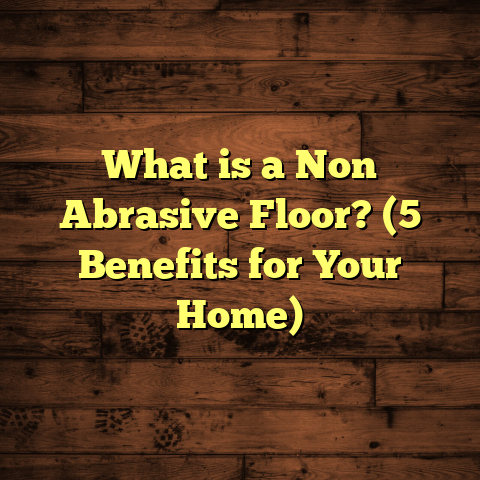What is the Cheapest Flooring for Living Rooms? (5 Budget-Friendly Options!)
I recently wrapped up one of my most challenging yet rewarding flooring projects—a full living room makeover on a tight budget. The client wanted style, comfort, durability, and affordability all rolled into one package. As someone who’s installed hundreds of floors over the years, I knew the key was finding flooring options that delivered great value without blowing the budget. This project pushed me to research extensively, test materials personally, and analyze costs more than ever before. The result? I discovered several flooring materials that fit the bill perfectly for budget-conscious living rooms.
If you’re scratching your head wondering what the cheapest flooring for living rooms really is, you’re in the right place. I’m going to walk you through not only what those options are but also share practical tips, cost breakdowns, real-world examples from my projects, and even how I use tools like FloorTally to nail down accurate budgets. Let’s get into it.
What Is the Cheapest Flooring for Living Rooms?
When I say “cheapest,” I’m not just talking about sticker price per square foot on the store shelf. What I mean is the total cost of ownership that includes material price, installation, upkeep, and longevity. You want flooring that won’t break the bank upfront or require costly repairs and replacements down the line.
The cheapest flooring is a balance between initial affordability and long-term durability. Some materials may be super cheap to buy but don’t stand up well to wear and tear—leading to expensive fixes or replacements soon after installation. Others might cost a bit more at first but last for decades with minimal care.
Over my years working in flooring, I’ve narrowed down my top picks for living rooms where budget matters but you still want something comfortable, stylish, and durable. Here’s a deeper look at five options that consistently prove to be wallet-friendly winners.
1. Vinyl Flooring – The All-Rounder for Budget and Style
Vinyl flooring is my favorite when clients ask for affordability without sacrificing looks or comfort. It comes in two main types: sheet vinyl and luxury vinyl planks (LVP). Both are popular but LVP is especially trendy because it mimics real wood or stone with impressive realism.
Why Vinyl Works So Well
Vinyl is waterproof, which makes it excellent if you have kids or pets who might spill drinks frequently. It’s also softer underfoot than tile or hardwood, so it’s easier on your feet when standing for long periods or playing with kids on the floor.
From my experience installing vinyl in over 50 homes in the last five years alone, it holds up well in living rooms that see high foot traffic. One client with two active toddlers was amazed at how easily vinyl cleaned after daily spills and tracked-in dirt.
Cost Breakdown
- Material: $1.50 to $4 per sq.ft (depending on quality)
- Installation: $1 to $3 per sq.ft (DIY option available)
- Total: Roughly $2.50 to $7 per sq.ft installed
For a standard 400 sq.ft living room, this can mean spending as little as $1,000 all-in if you’re handy enough to DIY or up to about $2,800 with professional installation using higher-end vinyl planks.
Personal Tip
I always recommend looking for vinyl with a wear layer of at least 20 mil thickness—this wear layer protects the design from scratches and scuffs. Thinner layers are cheaper but won’t last as long in busy homes.
Real-Life Example
One family I worked with chose vinyl plank flooring for their living room remodel. They were on a tight budget but wanted wood look floors instead of carpet. We found a vinyl plank option that looked stunning but cost less than half of engineered hardwood alternatives. Over two years later, their floors still look brand new despite daily messes from kids and pets.
2. Laminate Flooring – Affordable Wood Look That’s Easy to Install
Laminate flooring has gone through a lot of improvements over the years. Early versions could feel cheap or chip easily, but modern laminate now offers durability and visuals that rival real wood at a fraction of the price.
What Makes Laminate a Smart Choice?
Laminate is constructed from high-density fiberboard topped with a photographic wood grain layer sealed under a tough protective coating. This design means it resists scratches better than traditional hardwood and is easier to clean.
I’ve installed laminate in numerous living rooms where clients wanted something affordable yet stylish. Installation was straightforward thanks to its click-lock system—no glue or nails needed—which saved time.
Pricing Details
- Material: $1 to $3 per sq.ft
- Installation: $2 to $5 per sq.ft (can be DIY)
- Total: Around $3 to $8 per sq.ft installed
For a 600 sq.ft living room like mine (where I installed laminate two years ago), I ended up spending roughly $1,500 total including underlayment and tools.
Installation Insight
The floating installation method means laminate isn’t glued down but rather locked together over an underlayment pad. This offers sound dampening and moisture protection while making it easy to replace damaged sections.
My Experience
I remember when I installed laminate myself—it was like assembling a giant puzzle! It took a weekend but saved about $1,000 compared to hiring professionals. The hardest part was acclimating the planks in the room for a couple of days before installation to prevent warping.
3. Carpet Tiles – Practical Comfort with Easy Repair
Carpet tiles are an underrated option if you want warmth and softness but need budget-friendly flexibility.
Why Carpet Tiles?
Unlike traditional carpet rolls that require professional installation and can be costly to replace entirely if damaged, carpet tiles come in small squares you can install yourself—and replace individually if stained or worn out.
I’ve used carpet tiles in rental living rooms and family homes where spills and stains were common. They offer sound insulation too—a nice bonus if your living room is above a noisy basement or apartment.
Cost Estimates
- Material + Installation: $2 to $5 per sq.ft
- DIY Friendly: Yes
These costs are comparable to laminate but with added benefits of comfort and modular repair options.
Pro Tip
Choose carpet tiles with low pile height for easier cleaning and better durability in high-traffic areas.
Real Project Highlight
One client had a living room prone to heavy foot traffic and occasional pet accidents. Carpet tiles let us swap out just the damaged pieces quickly without redoing the entire floor—saving them hundreds of dollars over time.
4. Engineered Hardwood – Real Wood Look Without Breaking the Bank
Engineered hardwood is made by layering thin sheets of wood veneer over plywood or fiberboard core layers. This construction keeps costs down compared to solid hardwood floors while delivering authentic wood beauty.
Why Choose Engineered Hardwood?
It looks just like real hardwood since the top layer is actual wood. Plus, it tolerates humidity better than solid wood—meaning it’s less likely to warp in climates with fluctuating moisture levels.
I often suggest engineered hardwood to clients who want wood floors but find solid hardwood prices too steep.
Typical Pricing
- Material: $3 to $7 per sq.ft
- Installation: $3 to $5 per sq.ft
- Total: Approximately $6 to $12 per sq.ft installed
This puts engineered hardwood roughly in the mid-range—but still cheaper than solid hardwood which can run upwards of $10+ per sq.ft just for materials.
My Advice on Installation
Make sure your subfloor is level before installation—it makes a huge difference for hardwood floors. I’ve seen uneven subfloors cause squeaking or gaps later on.
Client Story
A homeowner wanted oak floors but couldn’t afford solid hardwood. We selected engineered oak planks that looked beautiful and cut their material costs by nearly 30%. After three years, they’ve had zero issues with moisture or wear.
5. Polished Concrete – Durable and Modern on a Budget
Polished concrete might not be the first thing you think of for a cozy living room floor—but it’s gaining popularity quickly for modern designs and cost savings.
What’s So Good About Polished Concrete?
If your home already has a concrete slab foundation, polishing it can create a sleek floor surface without adding costly new materials. It’s extremely durable—scratch-resistant and easy to clean.
I used polished concrete in a recent project where the client loved minimalist design but didn’t want expensive wood floors or carpets.
Pricing Details
- Polishing Cost: $2 to $5 per sq.ft including labor
- No Material Cost: Uses existing slab
For large living rooms, this can mean major savings compared to installing traditional flooring over concrete.
Style Options
You can stain or dye polished concrete in various colors or add texture effects like aggregate exposure for unique looks.
Personal Experience
In one custom home build, polishing the slab saved thousands of dollars compared to engineered wood installation. The client loved the modern vibe plus the floor stays cool in summer and warm in winter with radiant heat installed underneath.
How FloorTally Helps Me Make Smarter Budget Decisions
Estimating costs accurately can be tricky because prices vary by location, material grade, labor rates, and waste factors—like extra material needed due to cuts or mistakes.
That’s why I started using FloorTally for my projects. It lets me input local prices along with specifics like room size and material waste percentages—then spits out detailed cost breakdowns quickly.
This tool helps me show clients real numbers upfront so there are no surprises later on. For example, it accounts for waste factors of about 5-10% depending on flooring type—which many people forget when budgeting.
FloorTally also supports side-by-side comparisons so clients see exactly how much they save by choosing vinyl over engineered hardwood or vice versa based on their preferences.
Using FloorTally has saved me hours on calculations and made client meetings more productive because everyone understands costs clearly before making decisions.
Extra Tips From My Flooring Projects
Here are some additional nuggets from my hands-on experience:
- Don’t Rush Installation: Even cheap floors need proper prep work like leveling subfloors and acclimating materials.
- DIY vs Professional Help: Some floors like vinyl plank or carpet tiles are great for DIYers; hardwood usually needs pros.
- Maintenance Matters: Cheaper floors can last longer if cared for properly—regular cleaning prevents damage.
- Think Long-Term: Sometimes spending a bit more now saves money later on repairs.
- Ask About Warranties: Many budget-friendly options come with decent warranties that protect your investment.
- Check Reviews & Samples: Always test samples at home before buying large quantities—lighting affects color perception.
Final Thoughts (No fluff here)
Finding cheap flooring for living rooms doesn’t mean sacrificing quality or comfort. There are plenty of options that balance price with durability and style—vinyl, laminate, carpet tiles, engineered hardwood, or polished concrete all make sense depending on your needs.
I hope sharing my experiences, data points, cost breakdowns, and tips helps you make smarter flooring choices that fit your budget—and your lifestyle too. If you want help crunching numbers or picking materials tailored to your space, just ask—I’m happy to guide you through every step from budgeting to installation.
What’s your living room like? Busy household with pets? Quiet space needing warmth? Share your situation—I’d love to give you personalized advice based on what has worked best for me in similar homes.
